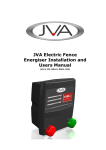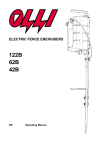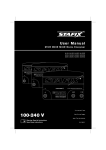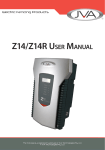Download Best Power B510-2000U Instruction manual
Transcript
B Series Battery Powered Electric Fence Energiser Models B310, B510 and B1010 INSTRUCTION MANUAL Warning - Regular inspections of electric fences must be undertaken to ensure continued operational safety and compliance with Australian Standard AS/NZS 3350.2.76:2000. - Persons coming into contact with high voltage pulses may have their normal physiological functions interrupted. - Young children and infirm persons should not be left unsupervised in the vicinity of an electric fence energiser or fence. - Read this instruction manual fully before installing or operating the energiser. - Extended periods of sunlight and excessive heat on the liquid crystal display will cause deterioration over time. This is not covered by warranty. WARRANTY THUNDERBIRD Electric Fence Systems Thunderbird warrant all electric fence systems against defective workmanship and faulty materials for 2 years from the date of purchase. We undertake, at our option, to replace or repair free of charge each product, or part thereof, on condition that it is returned to our factory freight prepaid, and found on examination to be suffering from material or constructional defect. We cannot be held responsible for any repair other than those carried out by us or our authorised agent. A photocopy of your proof of purchase and a request for warranty must also be returned with the item. Specifications Battery Voltage - 12Vdc nominal Battery Current - Off - <1mA Standby - 60mA B310 120 - 250mA B510 180 - 480mA B1010 380mA - 880A Output Voltage - 9.5kV no load nominal Max Output B310 - 2.0J at 350 ohms resistive load B510 - 3.8J at 250 ohms resistive load B1010 - 7.0J at 250 ohms resistive load Description The B310, B510 and B1010 are high power energisers designed to be powered from a 12V battery. They incorporate latest technology components with several innovative features for a battery energiser. A large easy to use keypad is the main feature, which makes it unique for this class of energiser. A number of parameters can also be adjusted on this range. Output voltage (hence power), the pulse period, and alarm voltage can all be set. The current drain on the battery is able to be varied from rated current to around 40% of the rated current by changing the output power and pulse period. This is especially useful on solar systems if there is a 1. This warranty is void if the product is subject to improper use or handling, incorrect power input voltage, damage through contact with chemicals, flooding, fire, explosion, excessive heat, lightning strikes, insect damage, or damage to external wiring. 11 Industrial Avenue Mudgee NSW 2850 Phone: 02 63723600 Fax: 02 63722597 Country Electronics Pty Ltd ABN 38 003 806 040 PO Box 391 Mudgee NSW 2850 Email: [email protected] For your records: Model No.: ............................................................................................. Serial No.: ............................................................................................. Date of Purchase: ................................................................................. Place of Purchase: ................................................................................ Receipt No.: .......................................................................................... 10. - 2 metres for power lines operating at a voltage not exceeding 1000V - 15 metres for power lines operating at a voltage exceeding 1000V > Electric fences intended for deterring birds from roosting on buildings, no electric fence wire shall be connected to an earth electrode. A warning sign must be fitted to every point where a person or persons may gain access to the conductors. > Where an electric fence crosses a public pathway, a non-electrified gate must be incorporated into the electric fence at that point, or a crossing by means of stiles must be provided. At any such crossing, the adjacent electrified wires must carry warning signs. > Any part of an electric fence that is installed along a public road or pathway must be identified at frequent intervals by warning signs securely fastened to the fence posts or firmly clamped to the fence wires. > The size of the warning sign must be at least 100mm x 200mm. > The background colour of both sides of the warning sign is to be yellow. > The inscription on the sign is to be black and shall be either the symbol shown in figure BB1 of the Standard, or the words “WARNING - ELECTRIC FENCE”. > The lettering on the sign must be indelible, be on both sides of the sign and in letters not less than 25mm in height. > Ensure at all times that mains operated ancilliary equipment connected to the electric fence circuit provides a degree of isolation between the fence circuit and the mains supply equivalent to that provided by the fence energiser. > This energiser must be installed in accordance with the Australian Standard. long period of cloudy weather. A 16 character x 2 line display also indicates the condition of the fence as viewed by the energiser. Fence voltage, current and stored joules are displayed while the unit is running. Warning beeps are given when the unit is about to turn on. This is a safety feature that warns the operator to keep clear of the output terminals. The buzzer also sounds if the output voltage falls below the alarm voltage setting. Installation The fence to be powered must be constructed properly to ensure reliable operation. The following should be particularly noted: - Do not use rusty wire. A good galvanised coating is required to make a reliable connection between the fence wires. -Avoid using polywire or polytape on extended runs. Hot tape and polywire may be used for runs of up to 400m in any one direction. Super polywire and polytape may be used for runs up to 1500m in any one direction. The resistance of these products makes them ineffective for greater distances. Use galvanised wire for long runs. - All wire joins must be made with joint clamps. Twisted wire joins are subject to a zinc oxide insulation barrier building up between the wires, especially after it has been wet. A properly tightened joint clamp fuses the 2 galvanised wires together. - Good earthing is essential. Use 3 earth stakes near the energiser and 1 every kilometre along the fence. The stakes must be galvanised. Do not use copper stakes or normal tar covered steel posts. See the accompanying helpful hints brochure. - A minimum of one earth return wire is required to ensure reliable operation, especially in dry sandy or rocky areas. The ground can be a poor conductor in dry times which makes the electric fence ineffective. If using a solar system or stand alone battery in the field, make sure that the energiser is mounted vertically so that the connections are at the bottom of the energiser. This will prevent rain or dew from entering the case. DO NOT leave the energiser laying on the ground. 9. 2. Fence Connections - Connect the fence live wire to the “FENCE” terminal, and the earth stakes and earth return wire to the “EARTH” terminal. Battery - The attached battery clips must be connected to an external 12V battery. Red goes to the positive terminal and black to the negative. Battery and Solar Panel Selection For solar use or stand alone battery use, the minimum recommended sizes are: B310 - 70 amp hour deep cycle or solar rated B510 - 100amp hour deep cycle or solar rated B1010 - 200 amp hour deep cycle or solar rated These battery sizes will give a maximum of approximately 10 days running time without any charge. It is not recommended to run a lead acid battery completely flat however. Repeatedly discharging a battery by more than 40-50% will severely shorten its life. If the energiser is to run continuously using solar power, the minimum recommended sizes of solar panels are as follows: B310 - 20W solar panel B510 - 40W solar panel B1010 - 80W solar panel These panels require a solar regulator. The output of the regulator should be connected directly to the battery. The size of the panel may have to be increased for higher latitude locations such as Southern Victoria or Tasmania. Alternatively, the energiser may be operated at reduced power or a slower pulse rate. This is recommended anyway during extended periods of cloud. Ensure that the solar panel is facing the equator, and that it can receive full sun throughout the day. The solar panel should be angled at approximately 10 degrees more than your latitude for maximum effect during the winter period. 3. Instructions for Installation of Electric Fences for Animals The following information is taken from the AustralianStandard AS/NZS 3350.2.76:1998 Amendment 2. Refer to this or a later standard for the full details on electric fencing. > Electric fences must be installed and operated so that they do not cause an electrical hazard to persons, animals or their surroundings. > Construction of electric fences that is likely to lead to entanglement of animals or persons is to be avoided. > An electric fence must not be supplied from two separate energisers or from independent fence circuits of the same energiser. > For any two separate electric fences that are supplied from separate independently timed energisers, the distance between the two wires must be at least two (2) metres. If this gap is to be closer, it must be effected by means of an electrically non-conductive (insulating) material and/or an isolated metal barrier. > Barbed wire or razor wire must not be electrified by an energiser. > A non-electrified fence incorporating barbed or razor wire may be used to support one or more offset electrified wires on an electric fence. The supporting devices for the electrified wires must be constructed so as to ensure that these wires are positioned at a minimum distance of 150mm from the vertical plane of the non-electrified wires. The barbed or razor wire must be earthed at regular intervals in accordance with Country Electronics earthing recommendations. (See helpful hints brochure) > A distance of at least 10 metres must be maintained between the energiser’s earth electrode and any other earthing system connected parts - for example, mains power protective earth or telecommunications sytem earth. > Electric fence connecting leads located inside buildings must be effectively insulated from the earthed structural parts of the building - use suitable high voltage insulated cable. Important: always ensure metal parts of the building are effectively earthed. > Electric fence connecting leads located underground must be run in a suitable conduit of insulating material, or high voltage insulated cable be used. Care must be taken that the effects of animal hooves or vehicle wheels sinking into the ground cannot damage the connecting leads. > Electric fence connecting leads must not be installed in the same conduit as mains supply wiring, communications cables or data cables. > Crossing with overhead power lines must be avoided wherever possible. If such a crossing cannot be avoided, it must be made underneath the power line and near as possible at right angles to it. > If electric fence connecting leads and wires are installed near an overhead power line, the clearances must not be less than indicated in the table below. Power Line Voltage - V Clearances - Metres Up to 1000V 3 1000V - 33000V 4 Above 33000V 8 > If electric fence connecting leads and wires are installed near an overhead power line, their height above the ground must not exceed 3 metres. This height applies either side of the orthogonal projection of the outermost conductors of the power line on the ground surface, for a distance of: 8. Trouble Shooting Operation Possible Cause Battery Lead off Remedy Reconnect battery The energiser can be turned on or off using the keypad. It remembers whether it’s on or off, in case the battery goes flat or if the battery is simply disconnected. Flat battery Battery voltage must be above 8V. Charge battery externally or connect a charged battery. See page 4 Note- If the energiser was off when the battery was disconnected, it will remain off when the battery is re-connected. It must be turned back on using the keypad in this instance. If the energiser turns on by either a keypad command or the battery being connected, it will give 5 short beeps and then start pulsing. No voltage on the fence Live wire shorted to ground Locate short and remove it Setting Output Level Low voltage on the fence Arcing insulator Locate faulty insulator and replace it Problem No display or functions Fence is ineffective Poor connection Make sure joint clamps are used on all joins, and they are firmly tightened. Poor earth Check that all earth connections are tight and that joint clamps are used. This is the most common problem. Earth problems Check that all earth connections are tight and that joint clamps are used. Use an earth return wire as shown in the accompanying helpful hints. 7. There are 3 output levels that can be set on the energiser. They are high, medium and low. To see the current level, press LEVEL. If the energiser was pulsing, the pulsing pauses to minimise the danger of accidentally touching the live wire. The current level is shown, and you will also be asked if you want to change it. Press YES to change, and NO to leave it. If neither are pressed, the energiser returns to normal after 10 seconds. If YES is pressed, use the up and down arrows (which are also YES and NO) to set the desired level. Press ENTER to accept the new level. If pulsing was occurring previously, pulsing will resume at the new level. The energiser will resume normal operation if no buttons have been touched for more than 10 seconds. Setting Pulse Period The pulse period can be changed from 1.4 seconds to 2.4 seconds in 0.1 second steps. Changing the pulse period to a slower rate reduces current consumption, and so extends the time between charges for a stand alone battery. To change the pulse period, press RATE. If the energiser was pulsing, the pulsing pauses to minimise the danger of accidentally touching the live wire. The current pulse period is shown, and you will also be asked if you want to change it. Press YES to change, and NO to leave it. If neither are pressed, the energiser returns to normal after 10 seconds. 4. If YES is pressed, use the up and down arrows (which are also YES and NO) to set the desired pulse period. Press ENTER to accept the new period. If pulsing was occurring previously, it will resume at the new pulse period. The energiser will resume normal operation if no buttons have been touched for more than 10 seconds. Setting Alarm Voltage The alarm voltage can be changed from 6.0kV to 2.0kV in 0.1kV steps. To change the alarm voltage, press ALARM. If the energiser was pulsing, the pulsing pauses to minimise the danger of accidentally touching the live wire. The current alarm is shown, and you will also be asked if you want to change it. Press YES to change, and NO to leave it. If neither are pressed, the energiser returns to normal after 10 seconds. If YES is pressed, use the up and down arrows (which are also YES and NO) to set the desired alarm voltage. Press ENTER to accept the new voltage. If the sensed voltage falls below the alarm level for more than 10 pulses, the energiser will start beeping and an alarm will be displayed on the screen. Fence Condition The display can indicate the condition of the fence. If the fence is OK, the volts should be high (around 6 - 8kV), and the amps should be low (1 - 10A, depending on the length of the fence). You should take note of the displayed values when the fence is in good condition. kilometre. If the short is several kilometres away, the energiser might not notice much of a change in load. For this reason it is wise to regularly inspect and check the voltage on the fence at different locations, especially in the outer areas, to make sure that it’s still functional. Alarms This range of energisers is capable of sensing fence, battery and internal problems. For a fence alarm, if the output voltage is below the set alarm voltage for more than 10 consecutive pulses, an alarm will occur. This count is reset if even 1 pulse is above the alarm voltage. When an alarm occurs, the energiser will beep and display the reason for the alarm on the screen. For a fence alarm, pressing ENTER will acknowledge and disable the alarm. However, this only silences the alarm. If the condition still exists after 24 hours, the alarm will occur again. If the problem is fixed within 24 hours after acknowledging the alarm, and there are 20 consecutive pulses above the alarm voltage, the alarm will be automatically reset. The display may show “Heavy Fence Load” after the ENTER button has been pressed to indicate that there is still a problem with the fence. The alarm may be reset by pressing ALARM, then ENTER within 10 seconds. Once the alarm has been reset, it will start checking for problems again. The energiser is also constantly monitoring itself in case a problem occurs internally. Should it detect a problem, the cause will be shown on the display. The unit should be returned to Thunderbird for repair if any unusal error is displayed. If a short or heavy load appears on the fence, the volts will decrease and the amps will increase. How much they change will depend on the severity of the load, the number of kilometres of fence connected, and the distance between the energiser and the short. Normal 2.5mm galvanised wire has a resistance of about 30 ohms per 5. 6.















